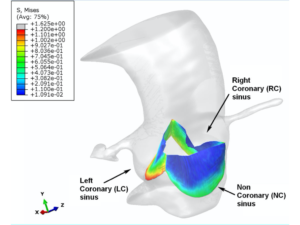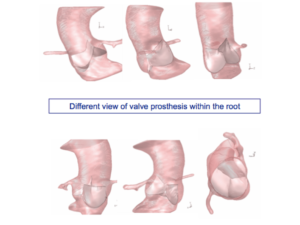Introduction
Aortic valve replacement is a common cardiac surgical procedure aiming at substituting the native (pathologic) aortic valve with an aortic valve prosthesis. Aortic valve replacement is associated with low perioperative mortality, minimal morbidity, and good longterm outcomes. With an idea to create a more physiological aortic valve, it was supposed that the optimal flow and valve function can be available with a valve which could be free of stent, synthetic materials, preserve the root dynamics, restore flexibility of the native valve annulus after decalcification and have minimal xenograft aortic wall, short implantation time and excellent hemodynamic performance to facilitate the left ventricular function [R1].
Goal
The goal of our study is to provide, by means of numerical tools, useful information in advance to cardiothoracic surgeons who aim at replacing a diseased aortic valve with a Freedom Solo prosthesis.
Methods
Finite Element Analyses are run to simulate the surgical procedure: a prosthesis model is implanted within an aortic root model. Simulations using different sizes can be carried out. Consequently, we are able to evaluate the best solution for a specific aortic root, primarily in terms of coaptation length and coaptation height.
Results
References
- [R1] M. Glauber, S. Solinas, and J. Karimov. Technique for implant of the stentless aortic valve Freedom Solo. Multimedia Manual of Cardiothoracic Surgery, 13:161-167, 2007.
Group publications
- [P1] Auricchio F., M. Conti, S. Morganti, and P. Totaro. A computational tool to support preoperative planning of stentless aortic valve prosthesis. Medical Engineering & Physics, 33(10):1183-92, 2011.



